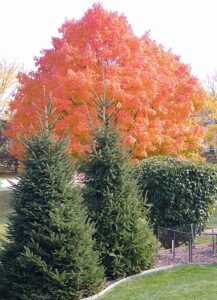The scientific genus name for the maple tree is Acer. One reason to like maple trees is they display marvelously beautiful colors in the Fall of the year. Another reason is that in addition, some species of maple trees will produce copious amounts of sap in the spring… which is used to make sweet and tasty… maple syrup!
(This page may contain affiliate links. See our disclosure about affiliate links here.)
Trees and Classifications

But I got interested in trees in my post-graduate work when I earned a graduate assistant job with a botany professor at DePauw University in Greencastle, Indiana. From my perspective, Dr. Howard Youse was nothing short of genius. In less than six weeks, Dr. Youse taught me more interesting Botany than I have learned in other subjects in an entire semester.
Howard the Leaf
It was certainly a great loss to his family, but also to the DePauw community and all his former students when Dr. Youse passed on in 2003. Some students, rather inappropriately – but certainly not irreverently – had referred to him as “Howard the Leaf”. It was not out of disrespect. As far as I know, the vast majority of students worshipped the ground on which he walked. I was one of those.
But I digress. One of the many lessons I learned from Dr. Youse was what I now refer to as the “miracle” of Maple syrup. That miracle starts with the necessary and proper identification of the best candidate Maple tree for sap and syrup. It’s pretty easy to identify a Maple in the summer – the leaves are still on the tree! But my assistantship was in the Fall. It’s a bit harder to identify the right tree when it has no leaves…
Best Candidate for Maple Syrup
However, of particular interest are 1) the Acer saccharum or sugar maple, 2) the Acer nigrum or black maple, and 3) the Acer rubrum or red maple. Of the 128 species of maple trees, sugar maple is the best candidate when it comes to making maple syrup, because that is the tree with highest concentration of sugar in the sap. Red maple is next, followed by black maple.
Sugar maples can live for up to 400 years (in the right conditions). Trees can be tapped earlier, but it takes fully forty years to reach premium age for tapping! It’s really not all that difficult to tap a tree, collect the sap and make the syrup. I did my own homework and thought I learned what I needed to know to teach the information to my students.
Important Information
In my haste to get my own syrup finished, I managed to miss a very important piece of information: it takes anywhere from 35 to 40+ gallons of sap to produce a single gallon of finished syrup! If you collect only one gallon of sap (128 oz.), expect to get just a bit over 3 oz. of Maple syrup for your pancake!
There are lots of other very important facts to know and learn before you start drilling holes in your maple tree, like
- How big in diameter your maple should be before you tap it
- How many taps you can safely place into a single tree
- When you can start collecting sap from your tree(s)
- Know some rules about proper sap handling
- Etc.
The Real McCoy
If you have ever tasted the delicious sweetness of real, pure maple syrup, it will be next to impossible to go back to the “store-bought” stuff. And once you understand all that goes into making a “batch” of the real Maple syrup, you will be able to smile and appreciate the fact that the real McCoy is worth the higher price tag!
A note from the author: A very special thank you to Allen Hustad for a personal tour of his machinery and explanation of the syrup-making process taking place at Hustad’s Sugarbush. And, for the maple sundae we enjoyed while there. Your maple syrup is awesome!
Follow this link for additional information on maple sugaring tips from the University of New Hampshire.
Follow this link for info on color classes and taste.
Additional Resources, Links & Products
- Roth Sugar Bush – Maple Sugaring Equipment (Cadott, WI) Visit their website to purchase supplies and view maple sugaring “how-to” videos
- Maple Tree Tapping Kit with 10 Taps (Amazon.com)
- How to Make Maple Syrup: From Gathering Sap to Marketing Your Own Syrup. A Storey BASICS® Title (Amazon book)